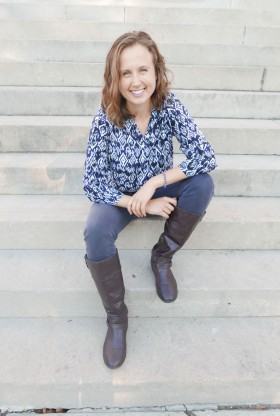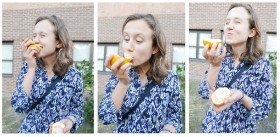Green Heart Highlight: Our Awesome Allie
Last week, Green Heart students taste-tested their way through the parts of a plant: they munched on a stem (cinnamon), a fruit (okra), a root (beets), and seeds (chocolate, made from cacao seeds). And next week, the kiddos will meet, greet, and team with the Compost Rangers—basically the Power Rangers of the local compost scene—to hunt for FBI (Fungi, Bacteria, and Invertebrates), which are the power-players of the composting process.
The brains behind these seriously fun (yet equally educational) lesson plans? Program director Allie Mason, who joined the team in July after a two-year stint as Farm Manager & Program Coordinator at the University of South Carolina (her alma mater). In addition to creating the GH curriculum, Allie leads the Program Managers and Garden Champions, and has grown the team from four to 14. “Under her lead we’ve recruited, trained, and now support four garden managers and six program managers that not only provide amazing support to our five gardens and 10 programs, but create a greater sense of community among our staff,” says executive director Drew Harrison. Here, learn more about Allie, her background in permaculture, and her green-hued, heart-shaped vision for the future.

Did you spend time in gardens as a child?
The time I spent in our backyard garden in Grand Rapids, Michigan, growing up was filled with raising and catching woodland critters, sketching the flowers and the trees, and going on adventure walks. My sister and I did nature art projects, stream fishing, fort building, fire starting, butterfly raising, and more, and were allowed the freedom to roam without supervision. Unless it was below zero degrees, we were outside in any weather condition.
Have you always been interested in permaculture and nutrition?
As a child, my mother loved taking us to farmer’s markets and showing us the talents tucked into our community while also exposing us to the idea of eating seasonally. When I was 18. I ventured down to South Carolina to attend the University of South Carolina in Columbia for the marine science program, originally having my heart set on becoming a scientific research diver. After a few semesters working in a lab and learning that marine scientists spend more time locked inside than swimming in the ocean, I realized I needed a change that better fit my desperate need to be outdoors. The summer after my junior year, I took a Permaculture and Design course in Punta Mona, Costa Rica, and it changed my life forever—really! For me, eating locally, besides the way it benefits our community/economy/footprint, is about the healing potential of foods and the incredible nutrition that comes from the freshest, closest source.
Overall, what’s the focus of the Green Heart curriculum?
The curriculum includes garden education, nutrition education, personal and social responsibility takeaways, and math and science concepts in each and every lesson. We have both an in-school and after-school program and the two curricula differ in the way that the in-school program intends to meet particular grade-level science and math standards, and the after-school program is based on a set of standards we formed through reading Big Ideas by the Center for Ecoliteracy that dives into food, culture, health, and the environment and key concepts within each of those topics. The sequence aligns with the seasons and what we intend to grow in the garden so that students can grasp the concept of seasonality in addition to checking the boxes for what they “need to know” at that age. Traditional school settings may not cater to students with diverse learning methods, so I do my best to make sure that there is an auditory, visual and kinesthetic component to each part of the lesson.
What’s an average day in the Green Heart “classroom” look like?
We begin each lesson by welcoming one another and any guests to the Green Heart classroom. During our very first lesson of the year, students learn how to give a proper “Green Heart handshake,” with a bone-crushing [read: firm] grip, staring into their partner’s soul [read: making good eye contact], and saying their greeting loud and proud [read: introducing themselves in a confident manner]. Following our welcome, we introduce the day’s lesson and ask the students how they can apply the Green Heart Rules of RESPECT to the day, by respecting themselves, respecting their Green Heart Buddies, and Respecting the Earth. Their answers give me chills. Beginning our lessons, we jump into a background discussion about the particular topic; if the lesson is an in-school session, it ties a gardening and health concept into their science lesson of the week, followed by a fun activity in the garden to enhance both their soft and hard skills. The after-school programs also include a strong culinary component in their curriculum, where we bring in guest chefs from the district and the community to teach our students how to make healthy dishes from food they harvest in the garden in addition to kitchen safety, knife skills, and other culinary concepts. At the end of the lesson, we circle up once again to share something new we learned and conclude with a taste-test that is linked to the lesson’s theme or focal crop. I always know that the lesson has been a hit when they ask if they’ll see me the next week and are eager to stick around afterwards and talk about the lesson’s content.

Why do you find school gardens so impactful in kids’ lives—and, too, in our greater community?
They are our last chance. We’ve hit far too many climate thresholds as a planet, experienced too much hate as a people, and fallen far from what matters the most. Farm-to-school programs as a whole have a say in what our future could look like. If we provide kids with an impactful education on the importance of healthy, local food and what that means for more than just their bodies, in 15 years from now when they are filling up their grocery carts (or farmer’s market baskets), their choices are going to look a lot different from what today’s consumers’ carts do. Their choices are going to bolster their local economy, reduce or possibly eliminate the effects and practice of destructive agricultural methods, all while nourishing their bodies instead of feeding disease. Kids will choose what is familiar to them, and if we make garden-grown vegetables and fruits the norm, then that’s what they’ll order on the cafeteria line or ask from their parents.

AT A GLANCE:
Favorite veggie? That’s not fair—I don’t think that there is a vegetable I don’t like. Regardless, I’d have to go with garlic. I grew up eating a lot of Middle Eastern food because we had some great neighbors from Syria who loved to feed me hummus, baba ghannoush, tabbouleh and whipped garlic on anything. I eat it roasted, I eat it sautéed, I eat it raw when I’m sick—really, I’ll put it in anything.
A peek at her resume: B.S. Environmental Science, Distinction in Global Leadership from the University of South Carolina (Columbia, SC); Permaculture and Design Certification from the Punta Mona Center for Regenerative Design (Punta Mona, Costa Rica); Advanced Permaculture Certification in Teaching from Cascadia Permaculture at O.U.R. Ecovillage (Vancouver, BC); and an in-the-works Nutritional Therapist Certification from Health Sciences Academy [U.K.]; and an in-the works Management Studies Certification from the University of London [U.K.], online.
Posted by Drew Harrison
On December 5, 2016
In Uncategorized
Comments on this post